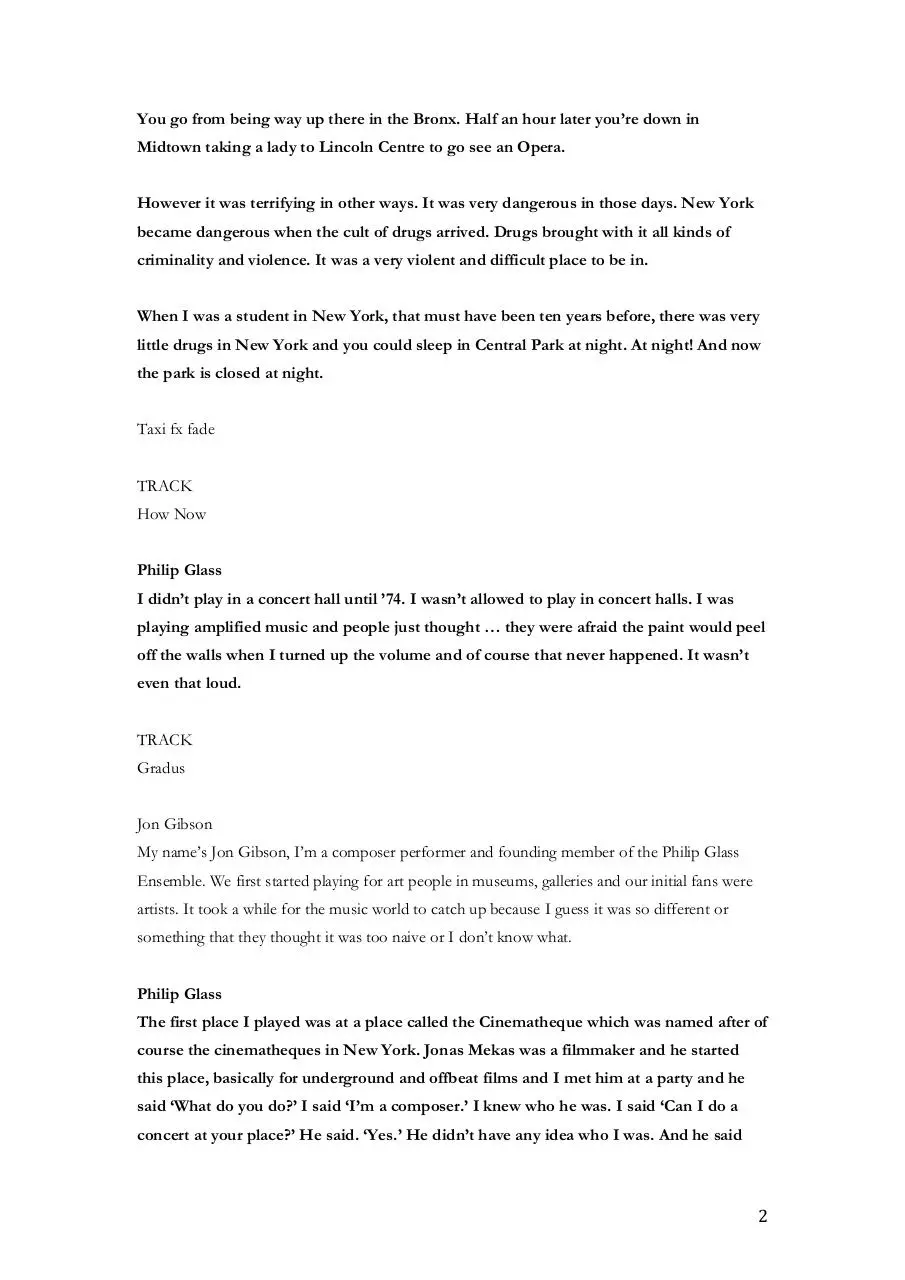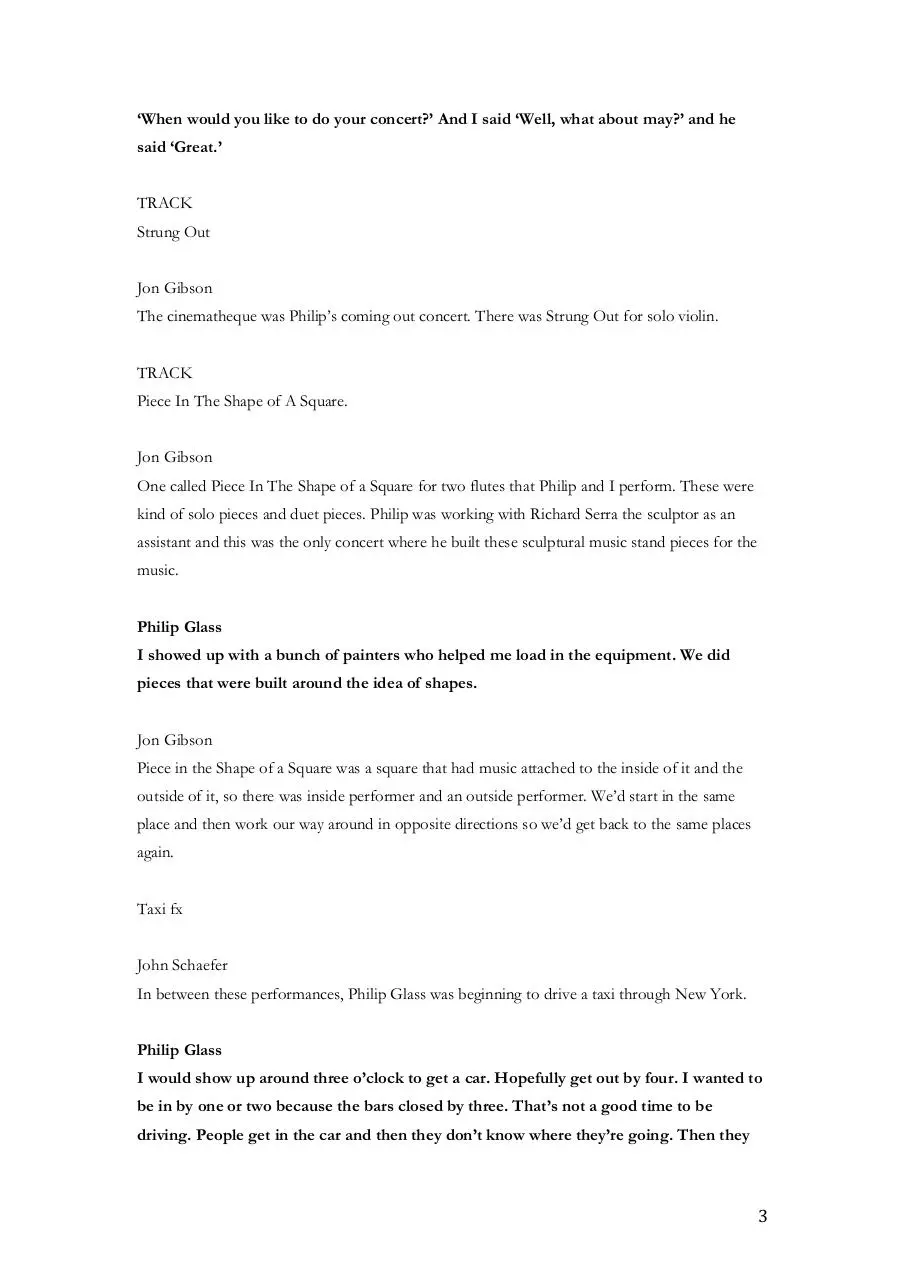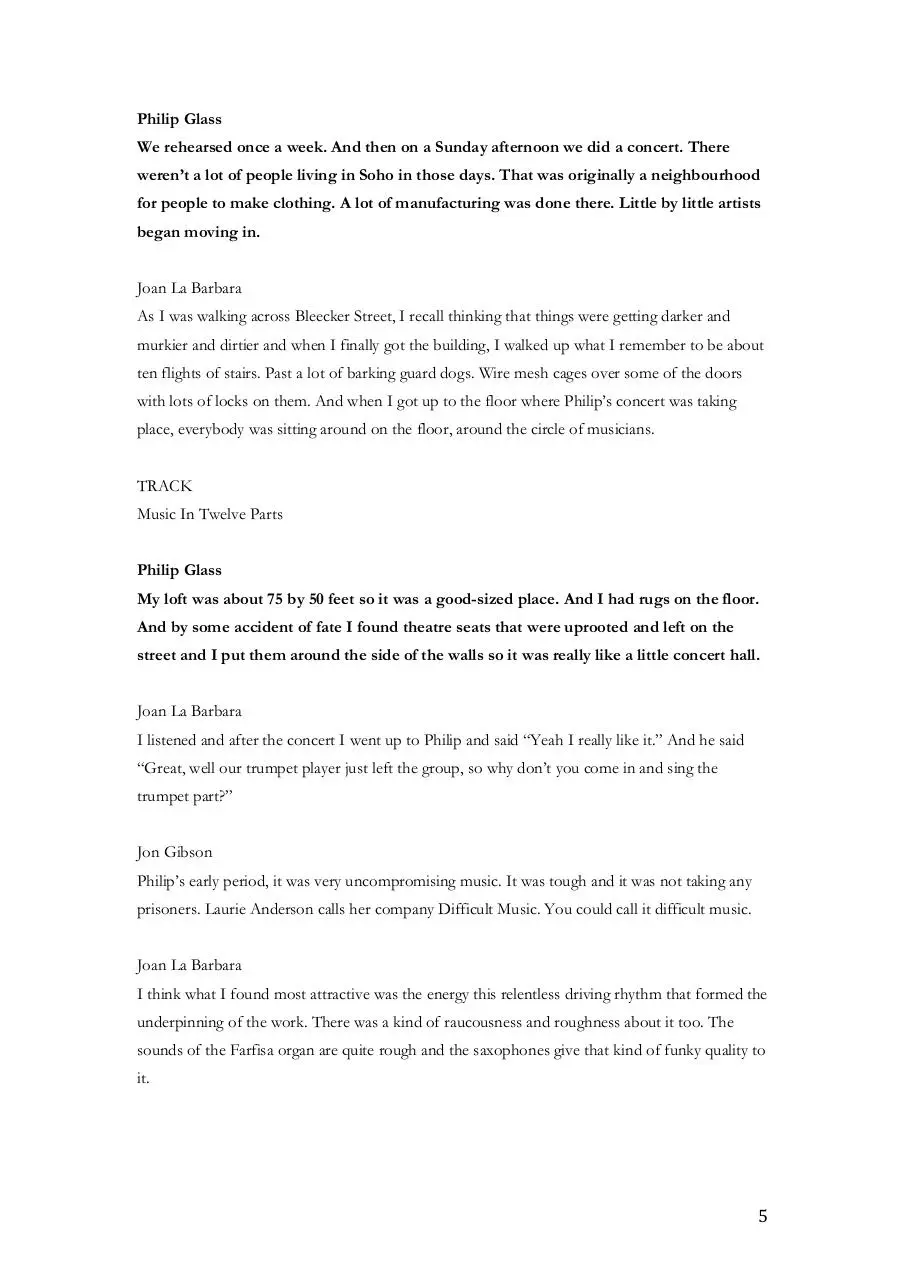Philip Glass transcript (PDF)
File information
Author: Just Radio
This PDF 1.3 document has been generated by http://www.convertapi.com, and has been sent on pdf-archive.com on 09/02/2016 at 13:31, from IP address 217.36.x.x.
The current document download page has been viewed 896 times.
File size: 218.68 KB (6 pages).
Privacy: public file





File preview
PHILIP GLASS: TAXI DRIVER
Produced by Paul Smith
A Just Radio production for BBC Radio 4 and BBC World Service
TX: 18th August 2015 (R4), 4th November 2015 (World Service)
10 minute extract
--Philip Glass
I was doing the kind of day labour that was very hard on my hands. I worked for a very
good friend of mine who was Richard Serra, but that was very heavy work and we were
working with lead and hot lead. I had learnt about that by working with a couple guys
who had a plumbing outfit. But the trouble with this kind of work was the day of
swinging wrenches around and then going home and playing the piano was hard. And
finally I ended up with taxi driving. That was the last of the day jobs, because it was the
easiest on my hands.
TRACK
Music in Twelve Parts
Philip Glass
I got to know the city very well. Within two or three weeks I could find my way around
the city. We have five boroughs here. You could be in Queens or the Bronx or Brooklyn,
Manhattan or Staten Island. Wherever I was I could find my way.
Taxi fx
Philip Glass
I enjoyed being in the city. Apart from the moments of terror. The city was a fantastic
slice of life in any way you looked at it. Whether you’re up in the Bronx or Bed Stuy in
Brooklyn or Harlem. There were times you were driving around New York and you
didn’t know what city you were in. There were bonfires on the corner and people staying
warm in the winter like that. And you say, ‘where the heck am I? I could be anywhere.’
1
You go from being way up there in the Bronx. Half an hour later you’re down in
Midtown taking a lady to Lincoln Centre to go see an Opera.
However it was terrifying in other ways. It was very dangerous in those days. New York
became dangerous when the cult of drugs arrived. Drugs brought with it all kinds of
criminality and violence. It was a very violent and difficult place to be in.
When I was a student in New York, that must have been ten years before, there was very
little drugs in New York and you could sleep in Central Park at night. At night! And now
the park is closed at night.
Taxi fx fade
TRACK
How Now
Philip Glass
I didn’t play in a concert hall until ’74. I wasn’t allowed to play in concert halls. I was
playing amplified music and people just thought … they were afraid the paint would peel
off the walls when I turned up the volume and of course that never happened. It wasn’t
even that loud.
TRACK
Gradus
Jon Gibson
My name’s Jon Gibson, I’m a composer performer and founding member of the Philip Glass
Ensemble. We first started playing for art people in museums, galleries and our initial fans were
artists. It took a while for the music world to catch up because I guess it was so different or
something that they thought it was too naive or I don’t know what.
Philip Glass
The first place I played was at a place called the Cinematheque which was named after of
course the cinematheques in New York. Jonas Mekas was a filmmaker and he started
this place, basically for underground and offbeat films and I met him at a party and he
said ‘What do you do?’ I said ‘I’m a composer.’ I knew who he was. I said ‘Can I do a
concert at your place?’ He said. ‘Yes.’ He didn’t have any idea who I was. And he said
2
‘When would you like to do your concert?’ And I said ‘Well, what about may?’ and he
said ‘Great.’
TRACK
Strung Out
Jon Gibson
The cinematheque was Philip’s coming out concert. There was Strung Out for solo violin.
TRACK
Piece In The Shape of A Square.
Jon Gibson
One called Piece In The Shape of a Square for two flutes that Philip and I perform. These were
kind of solo pieces and duet pieces. Philip was working with Richard Serra the sculptor as an
assistant and this was the only concert where he built these sculptural music stand pieces for the
music.
Philip Glass
I showed up with a bunch of painters who helped me load in the equipment. We did
pieces that were built around the idea of shapes.
Jon Gibson
Piece in the Shape of a Square was a square that had music attached to the inside of it and the
outside of it, so there was inside performer and an outside performer. We’d start in the same
place and then work our way around in opposite directions so we’d get back to the same places
again.
Taxi fx
John Schaefer
In between these performances, Philip Glass was beginning to drive a taxi through New York.
Philip Glass
I would show up around three o’clock to get a car. Hopefully get out by four. I wanted to
be in by one or two because the bars closed by three. That’s not a good time to be
driving. People get in the car and then they don’t know where they’re going. Then they
3
forget they’re in the car and they don’t know whether they’ve paid you. So best to get
back to the garage before two if you can. You take your hack licence and it was stacked
by the other hack licences by the order that you came in supposedly but we always
suspected that they shuffled them because we would see someone who came in after us
going out before us. But I always got out.
TRACK
Music In Twelve Parts
Philip Glass
I’d come home, sort of 1-6 I’d work on music. In those days I was writing Einstein on the
Beach, so I was writing music until about 6 in the morning. And then my kids, it was
nearly time for them to go to school. I’d take them to school. Then I would go to sleep
and I would sleep til around 3, then head over to the garage. I only had to do that 3 or 4
nights a week. 4 nights would be a lot because I could do it on 3 nights a week. It
depended on whether or not I needed the cash. The nice thing about that job was that
you had cash by the end of the day.
John Schaefer
By the time Philip Glass got here to New York, he was stepping into something that was a part
of the artistic ferment of the city. You had a city that was on the downturn and people could get
places to live quite cheaply so much of lower Manhattan became a haven for artists of all kinds
and they were friends, they were colleagues, they created work together.
TRACK
Circular Song
Joan La Barbara
This is Joan La Barbara. I was a member of the Philip Glass Ensemble from 1974-76. I believe I
was the first singer to work in the Ensemble.
I was doing work in the early 70s with Steve Reich. And it was at a gallery in Soho, someone
pointed out Philip Glass to me and I went over and introduced myself to him. I said “I’m a
singer and a composer, have you ever thought of using voice in your ensemble?” He said, “Well
we’re doing a concert over on Bleecker and Bowery this weekend, why don’t you come over and
listen?’
4
Philip Glass
We rehearsed once a week. And then on a Sunday afternoon we did a concert. There
weren’t a lot of people living in Soho in those days. That was originally a neighbourhood
for people to make clothing. A lot of manufacturing was done there. Little by little artists
began moving in.
Joan La Barbara
As I was walking across Bleecker Street, I recall thinking that things were getting darker and
murkier and dirtier and when I finally got the building, I walked up what I remember to be about
ten flights of stairs. Past a lot of barking guard dogs. Wire mesh cages over some of the doors
with lots of locks on them. And when I got up to the floor where Philip’s concert was taking
place, everybody was sitting around on the floor, around the circle of musicians.
TRACK
Music In Twelve Parts
Philip Glass
My loft was about 75 by 50 feet so it was a good-sized place. And I had rugs on the floor.
And by some accident of fate I found theatre seats that were uprooted and left on the
street and I put them around the side of the walls so it was really like a little concert hall.
Joan La Barbara
I listened and after the concert I went up to Philip and said “Yeah I really like it.” And he said
“Great, well our trumpet player just left the group, so why don’t you come in and sing the
trumpet part?”
Jon Gibson
Philip’s early period, it was very uncompromising music. It was tough and it was not taking any
prisoners. Laurie Anderson calls her company Difficult Music. You could call it difficult music.
Joan La Barbara
I think what I found most attractive was the energy this relentless driving rhythm that formed the
underpinning of the work. There was a kind of raucousness and roughness about it too. The
sounds of the Farfisa organ are quite rough and the saxophones give that kind of funky quality to
it.
5
New York in the 70s was gritty. You really made a commitment when you moved to New York.
It was noisy. It was dirty. That was sort of the rhythm of the city. You learnt to walk down
certain streets and not other streets and if you saw a group of characters congregating on one
side of the street you moved to the other street and walked a little bit faster. The choices of
instruments that Philip made I believe were really to reflect that kind of grittiness.
6
Download Philip Glass transcript
Philip Glass transcript.pdf (PDF, 218.68 KB)
Download PDF
Share this file on social networks
Link to this page
Permanent link
Use the permanent link to the download page to share your document on Facebook, Twitter, LinkedIn, or directly with a contact by e-Mail, Messenger, Whatsapp, Line..
Short link
Use the short link to share your document on Twitter or by text message (SMS)
HTML Code
Copy the following HTML code to share your document on a Website or Blog
QR Code to this page

This file has been shared publicly by a user of PDF Archive.
Document ID: 0000338672.